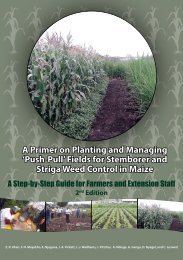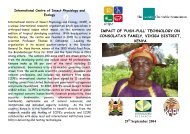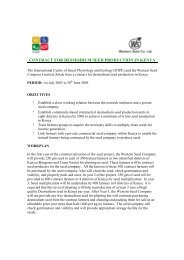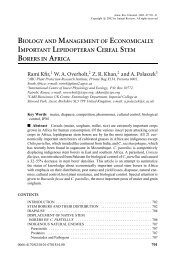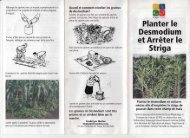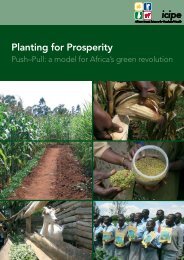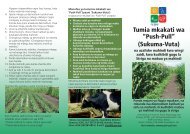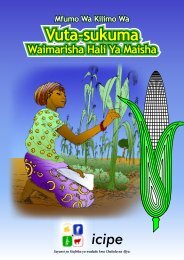The Royal Society Report - Push-Pull
The Royal Society Report - Push-Pull
The Royal Society Report - Push-Pull
Create successful ePaper yourself
Turn your PDF publications into a flip-book with our unique Google optimized e-Paper software.
used for time spans of days or months, or the entire crop<br />
growing season, or per year. At the leaf or plant scale, it<br />
can be applied when considering the flow of CO 2 and<br />
water vapour into and out of leaves. <strong>The</strong> highest WUEs can<br />
often be achieved when productivities are very low.<br />
Improvements therefore need to be balanced against the<br />
need to maintain yields.<br />
2.2.2 Water use and its impacts<br />
Agriculture currently accounts for around 70% of annual<br />
use of global water resources (FAO 2002; WRI 2005). In<br />
hot, dry regions, much larger amounts of water are needed<br />
to produce the same grain yield than in less stressed<br />
regions (Wallace & Gregory 2002).<br />
Most of the water used in agriculture is for irrigation.<br />
Globally, irrigated areas of land are increasing, although the<br />
rate of increase appears to be slowing (Faurèsa et al. 2003).<br />
Although irrigated areas account for less than 20% of the<br />
world’s cropped land, they produce nearly 50% of the<br />
global food (Döll & Siebert 2002). Reduction in irrigated<br />
areas or the amount of irrigation could therefore have very<br />
serious impacts on global food supply.<br />
Significant abstraction of water for irrigation has resulted in<br />
large reductions in river flows (Ma et al. 2003) leading to<br />
general environmental degradation and in extreme cases to<br />
an acceleration of desertification and more ‘super’ dust<br />
storms. Increased agricultural activity driving increased<br />
desertification can drive climate change at an increased rate.<br />
Water levels in many major regional aquifers and ground<br />
water levels in many regions have fallen to unprecedented<br />
levels (Wu 2007). Exploitation of land and unsustainable<br />
practices, particularly in arid regions, can result in severe<br />
degradation of soils and potential desertification, initiated by<br />
loss of vegetation and soil erosion.<br />
Using predictions of future availability of irrigation water<br />
(eg Scholze et al. 2006), it will be important to identify the<br />
most vulnerable people, places and sectors (climate<br />
change hotspots) but there is currently a shortage of good<br />
quality information of this kind. At a regional scale, the<br />
major problems in water supply are in regions with low<br />
rainfall and high evaporative demand, and those with<br />
expanding populations, such as North Africa, Southern<br />
Africa and the Near East (Wallace & Gregory 2002; FAO<br />
2003). Wealthy countries that are short of water often<br />
import food from elsewhere, meaning that ‘virtual water’ is<br />
traded, which may be to the detriment of the environment<br />
in the source country.<br />
<strong>The</strong> food supply chain and other crop trades exert many<br />
pressures on global water resources, with a resultant strain<br />
on the human population and ecosystems worldwide<br />
(Chapagain & Orr 2008a). <strong>The</strong> production of food, biofuel<br />
and other commodities can drive over-abstraction and<br />
pollution of groundwater and freshwater ecosystems in<br />
many water-scarce parts of the world. Decisions on the<br />
use of water for irrigated agriculture are therefore<br />
increasingly moral and ethical choices, as well as<br />
economic ones. Understanding how much water a nation<br />
(or a business) requires—its water footprint (WF)—and<br />
how this water is consumed (different crops grown in<br />
different climatic zones with different cropping, processing<br />
and transport methods) is the first step in forming views on<br />
the appropriateness of different food choices.<br />
<strong>The</strong> agricultural WF of the UK is 74.8 Gm 3 /yr or 73% of the<br />
total WF. <strong>The</strong> internal WF of UK agriculture is 28.4 Gm 3 / yr<br />
while the external component is 46.4 Gm 3 /yr. A larger<br />
share of the internal WF is related to livestock production<br />
and cereal products (wheat and barley), whereas the larger<br />
share of the external WF (EWF) is related to products<br />
originating from oil crops, cotton products, livestock<br />
products and stimulants (coffee, tea and cocoa). Most of<br />
the products responsible for the EWF are not grown in the<br />
UK, mainly because of unsuitable agro-climatic conditions<br />
(Chapagain & Orr 2008b).<br />
Reducing the use of agricultural water is an aim that<br />
requires combined agronomic, physiological,<br />
biotechnological/genetic and engineering approaches<br />
which may be collectively described as water saving<br />
agriculture. As Kofi Annan, UN Secretary General,<br />
declared, ‘we need a Blue Revolution in agriculture that<br />
focuses on increasing productivity per unit of water—more<br />
crop per drop’ (UN 2000). This issue has been summarised<br />
recently by Pennisi (2008).<br />
2.2.3 Increasing risks of flooding<br />
Existing weather patterns leading to river and coastal<br />
flooding have a dramatic effect on crop production.<br />
Particularly sensitive areas in this context are the deltas of<br />
southeast Asia which provide much rice for local and<br />
regional consumption. <strong>The</strong> consequences of increasingly<br />
turbulent and unpredictable weather patterns, driven by<br />
climate change, have been discussed in many studies<br />
(eg Scholze et al. 2006). Rising sea levels leading to<br />
exacerbated coastal flooding are predicted to have<br />
dramatic effects on many countries.<br />
2.3 Temperature<br />
Recent reports suggest that global temperature increases<br />
are occurring more rapidly than previously predicted (Field<br />
2009). In early February 2009, for example, southeastern<br />
Australia experienced temperatures of up to nearly 50°C.<br />
A risk of more frequent catastrophic crop failure is<br />
correlated with an increase in the frequency of extreme<br />
events (Semenov 2009).<br />
Temperature is an important factor in controlling changes<br />
in the development of plants. An increase in temperature<br />
caused by climate change is predicted to speed plant<br />
development (Sadok et al. 2007). When combined with the<br />
lengthening of the cropping season, this change may<br />
increase yield. However, when assessing the effects of<br />
temperature on crop yield, it is necessary to take account<br />
of extremes, particularly if these occur during the sensitive<br />
stages of growth. Different developmental stages vary in<br />
sensitivity to temperature extremes. For instance, very<br />
significant reductions in the yield of wheat can be caused<br />
12 I October 2009 I Reaping the Benefits <strong>The</strong> <strong>Royal</strong> <strong>Society</strong>



